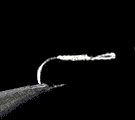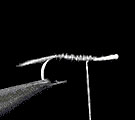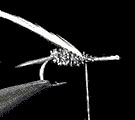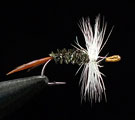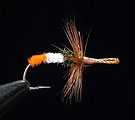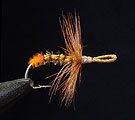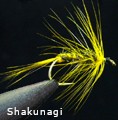Traditional Japanese Fly Tenkara 2 |
 |
| There are flies I got at various places or tied by myself. It is interesting that tenkara fly has local color. |
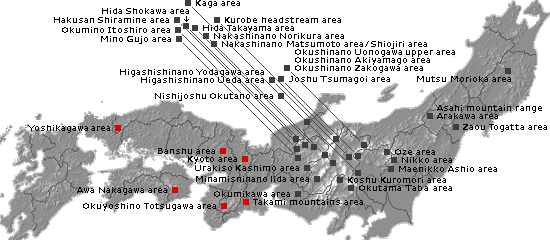 |
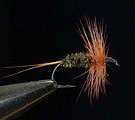 |
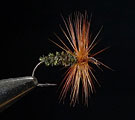 |
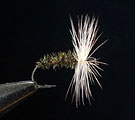 |
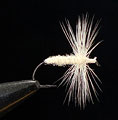 |
||||
Takami mountains area
In Takami Mountains at the prefectural border of Nara and Mie,
the headwaters of the Takamigawa River flowing to the west and the Kushidagawa River flowing to the east,
kebari-fishing was carried out with two flies attached.
It is kebari-fishing method devised by Mr. Kondo of Iitaka Ochikata (Upstream of the Kushidagawa River) in 1960s,
and was called "Shibaki" in the local area.
Very soft rod with slow taper of 2.4 to 2.7 m, heavy line with extreme taper, and tippet of about 1 m from No. 1.5 - 2.0 (3X -2X) were used.
Kebari of the tip is submerged in the water, a dropper of 20 cm attached to about 40 cm above tippet within the surface of the water,
and was operated to dance by the bend of the rod.
Kebari is a dry fly of stiff hackle, white hackle was used in the beginning of the season,
gray or brown hackle was used in the best season.
Using two hooks and dry flies etc is similar to the rig of Okuyoshino Totsukawa devised in the same time
but the route to hand down are different and the concept of fishing method is slightly different
so it seems unreasonable to say that they are the same origin, but it is not completely satisfied.
These are flies that I reproduced.References: Imai, K. (1993). Takami-sanchi ni tsutawaru 2-honbari Tenkara [Tenkara with 2 hooks that is handed down to Takami Mountains]. KEIRYU SPECIAL '93. Osaka: Weekly Sunday Fishing. |
|||||||
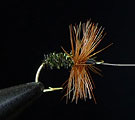 |
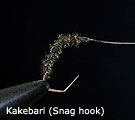 |
 |
 |
||||
Okuyoshino Totsukawa area
Kebari of a design by Mr. Naokazu Kono of Nishinaka Totsukawa-mura (village) that is at the southernmost of Nara and is the maximum village in Japan.
It is new around 1965 that the fishing method was fixed.
The hook was golden Sodegata No.9.
The hackle was bantam of orange-red color, and is tied thickly and cuts and arranges length.
The body was tied by peacock herl.
The rod length was 4.8m. The line and tippet was 5.4-5.5m in total length, the line No.1(4X),
and the ayu kakebari(Yajima type) No.9 was knotted to the tip of line.
Kebari was directly knotted to the upper 4-5cm position of the kakebari,
and a weight was attached to upper 1.5m position of the kebari, and a marker of the stalk of Japanese pampas grass was attached on upper 30cm position of a weight.
The rod is turned and cast on the head.
Kebari was given the action on the water surface.
The kakebari also was tied by peacock herl in order to do not shine.
These are flies I reproduced.References: Suzuno, F. (1993). Yamaryou [Mountain fishing]. Tokyo: Rural Culture Association. |
|||||||
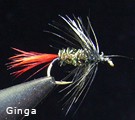 |
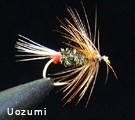 |
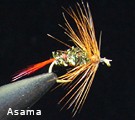 |
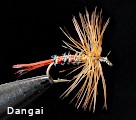 |
|||||
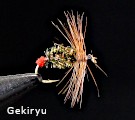 |
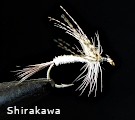 |
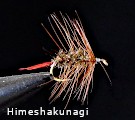 |
|
|||||
Banshu area
The history of Banshu flies originate in Takagun Banshu area (Nishiwaki Hyogo prefecture).
A record of methods of fly production of the late Edo Period has been found in the Banshu area.
The tradition of Banshu flies achieved through skillful incorporation of techniques developed in Kyoto, and it is carried on to this day.
Kaga, Tosa, and Banshu are well known as fly-producing region in Japan today.
Banshu flies are designated as a traditional craftwork of excellence by the Ministry of industry and Trade.
The photos are not kebari for Ayu, but are the present day kebari for Yamame (Amago) or Iwana.
These were arranged the patterns of traditional kebari for Yamame and Hasu, and were tied to the eyelet hook by Ryuobari honpo.References: Banshu Kebari. (October 2004 Leaflet), Banshu Tsuribari Coop, Kitaharima Industrial Deveropment Organization. |
||||||||
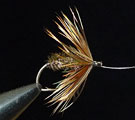 |
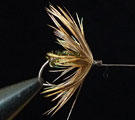 |
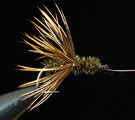 |
 |
|||
Banshu area
Kebari for Iwana (char) made by Nakagawa Mitsuo shop of Kurodasho Nishiwaki, Banshu.
The hook was Sode Marujiku (Round Shank) No.11 (Western hook size about #10).
The hackle is pheasant. The body is tied by peacock herl,
and the tippet of No.1 or 1.2 (about 4X) is attached about 30cm.
It is written on a bag with "Kebari Iwana-bari Nakayama-saku (work)".
Kebari in right end has a unique shape, and seems just effective for iwana fishing.
These are the same pattern as kebari of Hida Shokawa and Nikko, and are well known as a typical pattern of tenkara kebari but the origin of these kebari are not clear. |
||||||
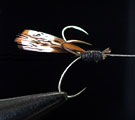 |
 |
 |
 |
||||
Western Chugoku Mountains Yoshikagawa area
The unique kebari (fly) fishing of Kakebari-shikake (Snag hook rig) at the Yoshikagawa River that is located in the border of Yamaguchi Prefecture and Shimane Prefecture.
The rod length was 4.5m from 4.2m.
As for the rig, a double hook of Ayu-kakebari Kitsune type No.8 is attached to the tip of No.0.8 (about 5X) line of about 2m,
and a Kebari that tied only the feather tips of a rooster copper pheasant (about 1.5cm) to a treble hook of Ayu-kakebari Kitsune type No.8 by cotton thread is attached on 5 or 6cm upper.
The kebari was pulled in reverse at a surface of the water, or was manipulated up and down.
It was a method of the fishing that was thought to fish at a tributary with many obstacles.
The double hook of tip rather than to hang a fish, seems to have attached in order to control the kebari by sinking in underwater,
and a marker of feather was set up on the middle of line.
In the upstream area of this flow Gogi ( Gogi is subspecies of Iwana.) is inhabited, but this kebari was used to catch Yamame.
This is kebari that I reproduced.References: Suzuno, F. (1993). Yamaryou [Mountain fishing]. Tokyo: Rural Culture Association. |
|||||||
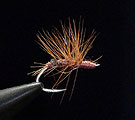 |
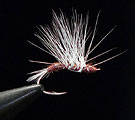 |
 |
 |
||||
Awa Nakagawa area
These are flies of Mr. Rikichi Maruyama who was master of kebari-tsuri (fly fishing) "Tobase-tsuri" that had been handed down at Tokushima Pref. Nakagawa area.
He was requested from the inn, and fished Amego (Amago) partly as a commercial fisherman besides hunting and mountain work around Mt. Tsurugisan.
The body was tied by cotton thread and peacock herl.
The hackle was long-tailed rooster of Tosa Kochi Pref.
and, it did not use tools, sit cross-legged, twined the thread to the great toe, and was tied.
The eye was not attached, so the tippet was tied directly to the neck of the fly and it was used.
The fiberglass rod for carp of 4.5m was used because it was similar to the old bamboo rod action.
The line was No.3, and was used from the same length as the rod to the twice length according to the width of river.
The tippet was No.0.8-1 (3-4lbs.) 60cm.
It was cast from the shoulder side with the three-quarter.
These are flies that I replicated.References: Yamamoto, S. (Ed.) (1989). Tenkara Fishing: Kebari-tsuri no Subete [Tenkara Fishing: All of Kebari fishing]. Tokyo: Ikeda Publishing. |
|||||||
My Best Streams |
Fukushima | Hinoematagawa Hinoemata | Tochigi | Ojikagawa Miyori | Yugawa Akanumachaya | Yamanashi | Yanagisawagawa Ochiai | Shiokawa Kuromori, Masutomi | Nagano | Daimongawa Iridaimon | Gifu | Shokawa Hirase | Oshirakawa Hirase | Isshikigawa Isshiki | A upper branch of Shokawa | | Mazegawa Kawaue | Itoshirogawa Itoshiro | Togegawa Itoshiro | Shirakawa Kashimo | Shiga | Adogawa Katsuragawa | Harihatagawa Furuya | Adogawa Kutsuki | Kitagawa Udotani | | Kitagawa Noge | A branch of Kitagawa | Asogawa Kijiyama | Amasugawa Amasugawa | | Echigawa Yuzurio | A branch of Echigawa | Shibukawa Kozuhata | Shibukawa Wanami | | Chayagawa Yakeno | Kyoto | Tananogawa Yamamori | Yuragawa Ashiu | Naesugidani Ashiu | Sasarigawa Sasari | | Katsuragawa Hirogawara | Kutagawa Kuta | Besshogawa Hanase | Nakatsugawa Kumogahata | Wyoming USA | Gibbon River and Madison River | Firehole River | Soda Lake | Colorado USA | Boulder Creek | South Boulder Creek (Upstream) | South Boulder Creek (Downstream) | Big Thompson River | Rocky Mountain National Park | South Island New Zealand | Lake Wakatipu | Mataura River | Ontario Canada | Credit River Erindale Park | |
Flies |
Equipment |
| Back to Main Home Page | Profile | Links |
Home |
Paper Craft of Japanese Trout and the World Trout © 1997 Yoshikazu Fujioka |
